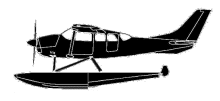
ASN Wikibase Occurrence # 210304
This information is added by users of ASN. Neither ASN nor the Flight Safety Foundation are responsible for the completeness or correctness of this information.
If you feel this information is incomplete or incorrect, you can submit corrected information.
| Date: | Monday 4 September 2017 |
| Time: | 14:30 |
| Type: |  Cessna U206G |
| Owner/operator: | Private |
| Registration: | N16GP |
| MSN: | U20604467 |
| Year of manufacture: | 1978 |
| Total airframe hrs: | 1576 hours |
| Fatalities: | Fatalities: 0 / Occupants: 4 |
| Aircraft damage: | Substantial |
| Category: | Accident |
| Location: | Kodiak, AK -
 United States of America United States of America
|
| Phase: | Take off |
| Nature: | Executive |
| Departure airport: | Kodiak, AK (T44) |
| Kodiak, AK | |
| Investigating agency: | NTSB |
| Confidence Rating: |
The airline transport pilot reported that, while attempting to takeoff in an amphibious, float-equipped airplane in choppy ocean waters, the airplane began to lose speed while simultaneously pitching forward. He subsequently aborted the takeoff, and the airplane struck a large swell, the right forward float strut fractured, the airplane rolled to the right, and the right wing's lift strut was substantially damaged. The pilot's initial examination of the airplane revealed that the left nosewheel was partially deployed even though the landing gear handle was in the "up" position.
Multiple witnesses observed the airplane depart to the east toward an area of unprotected water. One witness reported about 8-ft ocean swells in the unprotected area of the takeoff run, and another witness reported a strong wind from the east. Photos of the accident airplane taken during the rescue indicate rough water near the accident site with large ocean swells. Further, the forecast that day called for 9-ft seas and 25 knot winds. Guidance for takeoffs in float-equipped airplanes states that severe damage can occur when taking off in sea conditions with large swells. Although the pilot was aware of the ocean conditions he still attempted to takeoff in a protected area; however, the airplane did not lift off before reaching the ocean and encountered the large swells.
A postaccident examination of the airplane revealed that the left and right mechanical portion of the landing gear retraction system was improperly rigged, and the amphibious float cable loops were set to an inappropriately low tension load. No evidence of a hydraulic leak was present inside the amphibious floats or the fuselage.
Due to the improperly rigged landing gear, it is likely that the landing gear up-locks disengaged during the impact with the ocean swells. However, neither the pilot nor any of the witnesses reported the airplane yawing about its vertical axis during the takeoff run; thus, it is unlikely that the left nosewheel deployed during the accident airplane's water run. Furthermore, it is likely that the hydraulic lines were breached when the rear float struts were impact damaged, which then released hydraulic pressure and allowed the previously unlocked nosewheel to partially deploy after the accident.
Probable Cause: The pilot's improper decision to takeoff in an area of rough water and ocean swells, which resulted in a failure of the right wing lift strut.
Accident investigation:
 |
|
Sources:
NTSB
Location
Revision history:
| Date/time | Contributor | Updates |
|---|---|---|
| 01-May-2018 13:45 | ASN Update Bot | Added |
Corrections or additions? ... Edit this accident description
The Aviation Safety Network is an exclusive service provided by:


 ©2024 Flight Safety Foundation
©2024 Flight Safety Foundation